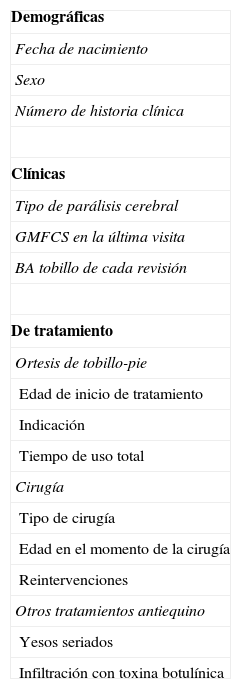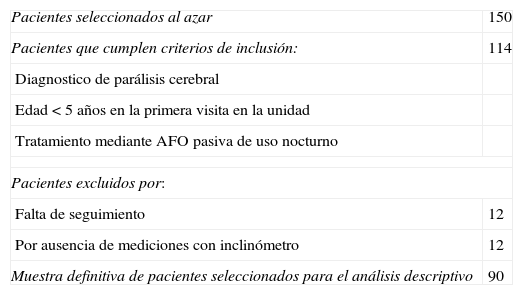El equinismo, que es la deformidad más frecuente en los pacientes con parálisis cerebral, aumenta la inestabilidad, dificulta la marcha y la adaptación a la silla de ruedas. La corrección del equinismo beneficia al niño deambulador, facilita la adecuada colocación del pie en el reposapiés de la silla de ruedas y la posibilidad de usar un calzado convencional en el niño que no tiene capacidad de marcha. El objetivo de este estudio es valorar si el uso nocturno de ortesis de tobillo-pie en ortoposición permite prevenir o diferir la aparición de equinismo y así evitar o retrasar la cirugía de alargamiento tendinoso.
Material y métodoSe ha realizado un estudio observacional descriptivo retrospectivo, revisando el historial clínico de pacientes diagnosticados de parálisis cerebral, tratados mediante ortesis de tobillo-pie nocturnas en la Unidad de Rehabilitación Infantil del Hospital Virgen Macarena.
ResultadosDe los 90 pacientes tratados con la ortesis de tobillo-pie nocturna, el 88,9% consiguió el rango de flexión dorsal necesario para la deambulación (≥10°) o la correcta adaptación a la silla de ruedas y al calzado (≥0°). Únicamente en 9 pacientes (10% de los casos) no se alcanzaron los objetivos pretendidos.
ConclusiónEl tratamiento preventivo con ortesis rígidas constituye una opción de primera línea en el tratamiento de la parálisis cerebral. El uso reglado y mantenido de las ortesis de tobillo-pie nocturnas puede retrasar la aparición del equinismo en la parálisis cerebral y permite diferir o evitar la cirugía con un beneficio funcional evidente.
Equinus, the most common deformity in patients with cerebral palsy, increases instability and impairs gait and adaptation to a wheelchair. Correction of equinus benefits walking children and aids proper placement of the foot on the footrest of a wheelchair. It also allows the possibility of using conventional footwear in children with no ability to walk. The aim of this study was to assess whether the use of an ankle-foot orthosis at night, keeping the foot in orthoposition, can prevent or delay the onset of equinus and thus prevent or delay tendon lengthening surgery.
Material and methodsWe performed a retrospective observational study based on a chart review of 90 patients diagnosed with cerebral palsy treated with a nocturnal ankle-foot orthosis in the Children's Rehabilitation Unit at Hospital Virgen Macarena in Spain.
ResultsOf the 90 patients treated with nocturnal ankle-foot orthosis, 88.9% achieved the dorsiflexion necessary for ambulation (≥10°) or adequate adaptation to a wheelchair and footwear (≥0°). Only 9 patients (10%) did not achieve the intended objectives with the use of the splint.
ConclusionPreventive treatment with a rigid ankle-foot orthosis is a widely accepted practice that constitutes a first-line option in the treatment of cerebral palsy. Systematic and persistent use of a nocturnal ankle-foot orthosis can delay the onset of equinus in cerebral palsy and can delay or avoid surgery, with a clear functional benefit.
Artículo
Comprando el artículo el PDF del mismo podrá ser descargado
Precio 19,34 €
Comprar ahora











